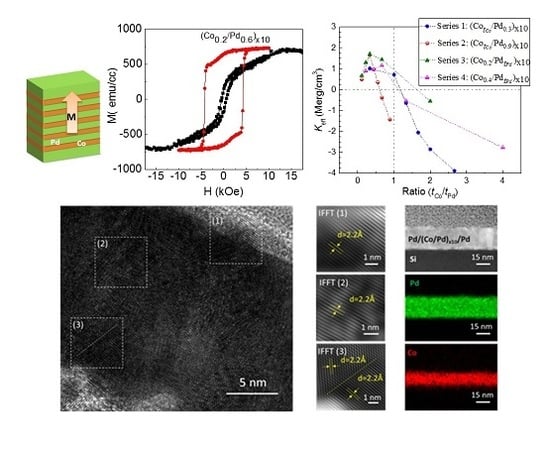Effect of Composition and Thickness on the Perpendicular Magnetic Anisotropy of (Co/Pd) Multilayers
Abstract
:1. Introduction
2. Materials and Methods
3. Results and Discussion
3.1. Effect of Co Thickness
3.2. Effect of Pd Thickness
3.3. TEM Characterization
3.4. Correlation Between Magnetic Anisotropy, Composition, and Lattice Parameters
4. Conclusions
Acknowledgments
Author Contributions
Conflicts of Interest
References
- Wolf, S.A.; Awschalom, D.D.; Buhrman, R.A.; Daughton, J.M.; von Molnár, S.; Roukes, M.L.; Chtchelkanova, A.Y.; Treger, D.M. Spintronics: A spin-based electronics vision for the future. Science 2001, 294, 1488–1495. [Google Scholar] [CrossRef] [PubMed]
- Wang, K.L.; Alzate, J.G.; Amiri, P.K. Low-power non-volatile spintronic memory: STT-RAM and beyond. J. Phys. Appl. Phys. 2013, 46, 074003. [Google Scholar] [CrossRef]
- Chappert, C.; Fert, A.; Van Dau, F.N. The emergence of spin electronics in data storage. Nat. Mater. 2007, 61, 813–823. [Google Scholar] [CrossRef] [PubMed]
- Tudu, B.; Tiwari, A. Recent Developments in Perpendicular Magnetic Anisotropy Thin Films for Data Storage Applications. Vacuum 2017, 146, 329–341. [Google Scholar] [CrossRef]
- Sbiaa, R.; Meng, H.; Piramanayagam, S.N. Materials with perpendicular magnetic anisotropy for magnetic random access memory. Phys. Status Solidi RRL—Rapid Res. Lett. 2011, 5, 413–419. [Google Scholar] [CrossRef]
- Piramanayagam, S.N. Perpendicular recording media for hard disk drives. J. Appl. Phys. 2007, 102, 2. [Google Scholar] [CrossRef]
- Slonczewski, J.C. Current-driven excitation of magnetic multilayers. J. Magn. Magn. Mater. 1996, 159, L1–L7. [Google Scholar] [CrossRef]
- Berger, L. Emission of spin waves by a magnetic multilayer traversed by a current. Phys. Rev. B 1996, 54, 9353–9358. [Google Scholar] [CrossRef]
- Katine, J.A.; Albert, F.J.; Buhrman, R.A.; Myers, E.B.; Ralph, D.C. Current-driven magnetization reversal and spin-wave excitations in Co/Cu/Co pillars. Phys. Rev. Lett. 2000, 84, 3149–3152. [Google Scholar] [CrossRef] [PubMed]
- Apalkov, D.; Khvalkovskiy, A.; Watts, S.; Nikitin, V.; Tang, X.; Lottis, D.; Moon, K.; Luo, X.; Chen, E.; Ong, A.; et al. Spin-transfer Torque Magnetic Random Access Memory (STT-MRAM). J. Emerg. Technol. Comput. Syst. 2013, 9, 13. [Google Scholar] [CrossRef]
- Kan, J.J.; Park, C.; Ching, C.; Ahn, J.; Xue, L.; Wang, R.; Kontos, A.; Liang, S.; Bangar, M.; Chen, H.; et al. Systematic validation of 2x nm diameter perpendicular MTJ arrays and MgO barrier for sub-10 nm embedded STT-MRAM with practically unlimited endurance. In Proceedings of the 2016 IEEE International Electron Devices Meeting (IEDM), San Francisco, CA, USA, 3–7 December 2016; pp. 27.4.1–27.4.4. [Google Scholar]
- Sajitha, E.P.; Walowski, J.; Watanabe, D.; Mizukami, S.; Wu, F.; Naganuma, H.; Oogane, M.; Ando, Y.; Miyazaki, T. Magnetization dynamics in CoFeB buffered perpendicularly magnetized Co/Pd multilayer. IEEE Trans. Magn. 2010, 46, 2056–2059. [Google Scholar] [CrossRef]
- Pal, S.; Rana, B.; Hellwig, O.; Thomson, T.; Barman, A. Tunable magnonic frequency and damping in [Co/Pd]8 multilayers with variable Co layer thickness. Appl. Phys. Lett. 2011, 98. [Google Scholar] [CrossRef]
- Sanvito, S.; Lambert, C.J.; Jefferson, J.H.; Bratkovsky, A.M. General Green’s-function formalism for transport calculations with spd Hamiltonians and giant magnetoresistance in Co- and Ni-based magnetic multilayers. Phys. Rev. B 1999, 59, 11936–11948. [Google Scholar] [CrossRef]
- Carcia, P.F.; Meinhaldt, A.D.; Suna, A. Perpendicular magnetic anisotropy in Pd/Co thin film layered structures. Appl. Phys. Lett. 1985, 47, 178–180. [Google Scholar] [CrossRef]
- Daalderop, G.H.O.; Kelly, P.J.; Schuurmans, M.F.H. Magnetic anisotropy of a free-standing Co monolayer and of multilayers which contain Co monolayers. Phys. Rev. B 1994, 50, 9989–10003. [Google Scholar] [CrossRef]
- Nakajima, N.; Koide, T.; Shidara, T.; Miyauchi, H.; Fukutani, H.; Fujimori, A.; Iio, K.; Katayama, T.; Nývlt, M.; Suzuki, Y. Perpendicular magnetic anisotropy caused by interfacial hybridization via enhanced orbital moment in Co/Pt multilayers: magnetic circular X-ray dichroism study. Phys. Rev. Lett. 1998, 81, 5229–5232. [Google Scholar] [CrossRef]
- Johnson, M.T.; Bloemen, P.J.H.; den Broeder, F.J.A.; de Vries, J.J. Magnetic anisotropy in metallic multilayers. Rep. Prog. Phys. 1996, 59, 1409. [Google Scholar] [CrossRef]
- Nemoto, H.; Nakagawa, H.; Hosoe, Y. Dependence of Co/Pd superlattice properties on Pd layer thickness. IEEE Trans. Magn. 2003, 39, 2714–2716. [Google Scholar] [CrossRef]
- Chung, W.S.; Yang, S.M.; Kim, T.W.; Hong, J.P. Ultrathin Co-O oxide layer-driven perpendicular magnetic anisotropy in a CoO/[Co/Pd]m multilayer matrix upon annealing. Sci. Rep. 2016, 6. [Google Scholar] [CrossRef] [PubMed]
- Den Broeder, F.J.A.; Kuiper, D.; Donkersloot, H.C.; Hoving, W. A comparison of the magnetic anisotropy of [001] and [111] oriented Co/Pd Multilayers. Appl. Phys. A 1989, 49.5, 507–512. [Google Scholar] [CrossRef]
- Carcia, P.F. Perpendicular magnetic anisotropy in Pd/Co and Pt/Co thin-film layered structures. J. Appl. Phys. 1988, 63, 5066–5073. [Google Scholar] [CrossRef]
- Jungblut, R.; Johnson, M.T.; Aan de Stegge, J.; Reinders, A.; den Broeder, F.J.A. Orientational and structural dependence of magnetic anisotropy of Cu/Ni/Cu sandwiches: Misfit interface anisotropy. J. Appl. Phys. 1994, 75, 6424–6426. [Google Scholar] [CrossRef]
- Zhang, S.; Zhao, D. Advances in Magnetic Materials: Processing, Properties, and Performance (582-624); CRC Press: Boca Raton, FL, USA, 2017; ISBN 978-1-4987-0673-5. [Google Scholar]
- Robinson, M.; Au, Y.; Knepper, J.W.; Yang, F.Y.; Sooryakumar, R. Magnetic imaging of layer-by-layer reversal in Co/Pt multilayers with perpendicular anisotropy. Phys. Rev. B 2006, 73, 224422. [Google Scholar] [CrossRef]
- Saji, K.J.; Tian, K.; Snure, M.; Tiwari, A. 2D tin monoxide—an unexplored p-type Can der waals semiconductor: Material characteristics and field effect transistors. Adv. Electron. Mater. 2016, 2. [Google Scholar] [CrossRef]
- Asahi, T.; Kuramochi, K.; Kawaji, J.; Onoue, T.; Osaka, T.; Saigo, M. Analysis of microstructures for Co/Pd multilayer perpendicular magnetic recording media with carbon underlayer. J. Magn. Magn. Mater. 2001, 235, 87–92. [Google Scholar] [CrossRef]
- Ota, M.; Itou, M.; Sakurai, Y.; Koizumi, A.; Sakurai, H. Perpendicular magnetic anisotropy in Co/Pt multilayers studied from a view point of anisotropy of magnetic Compton profiles. Appl. Phys. Lett. 2010, 96, 152505. [Google Scholar] [CrossRef]
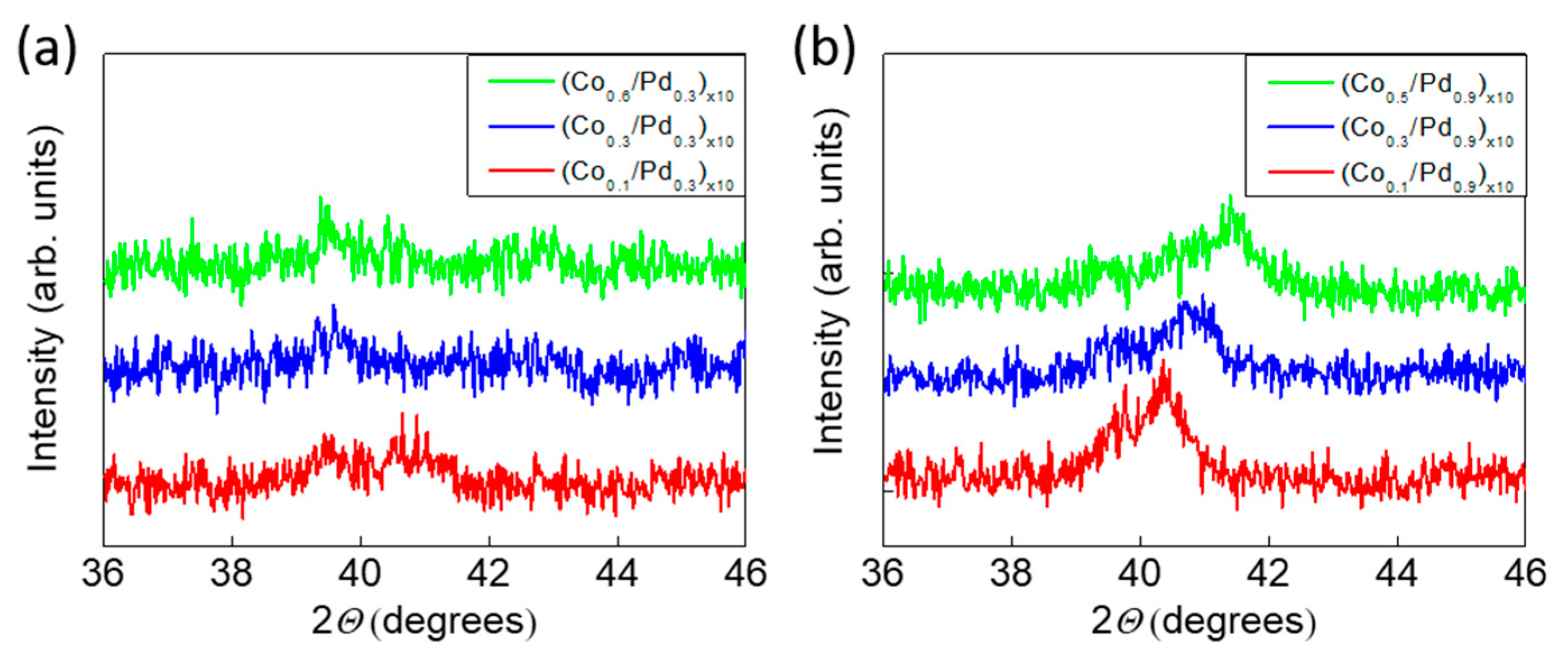
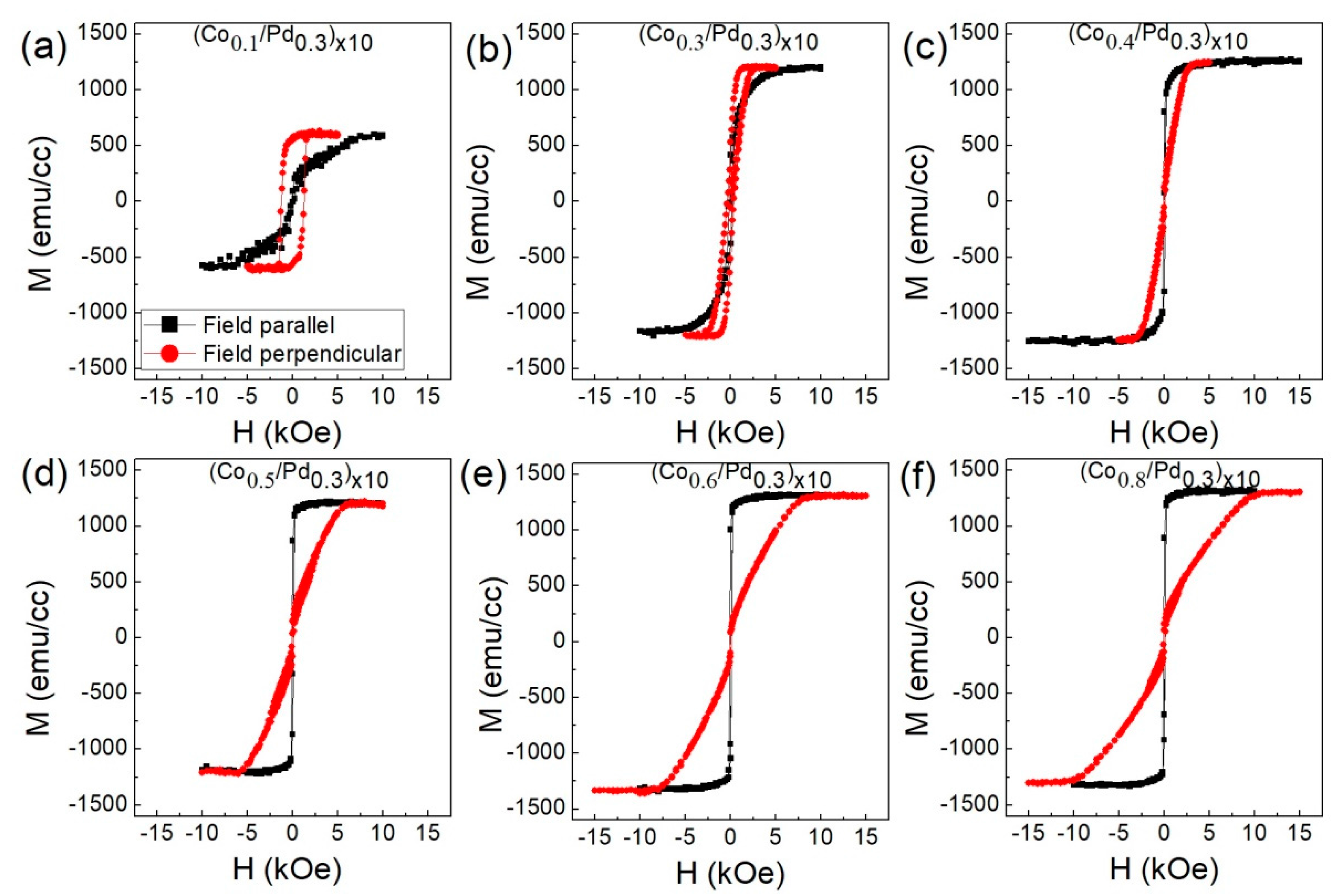
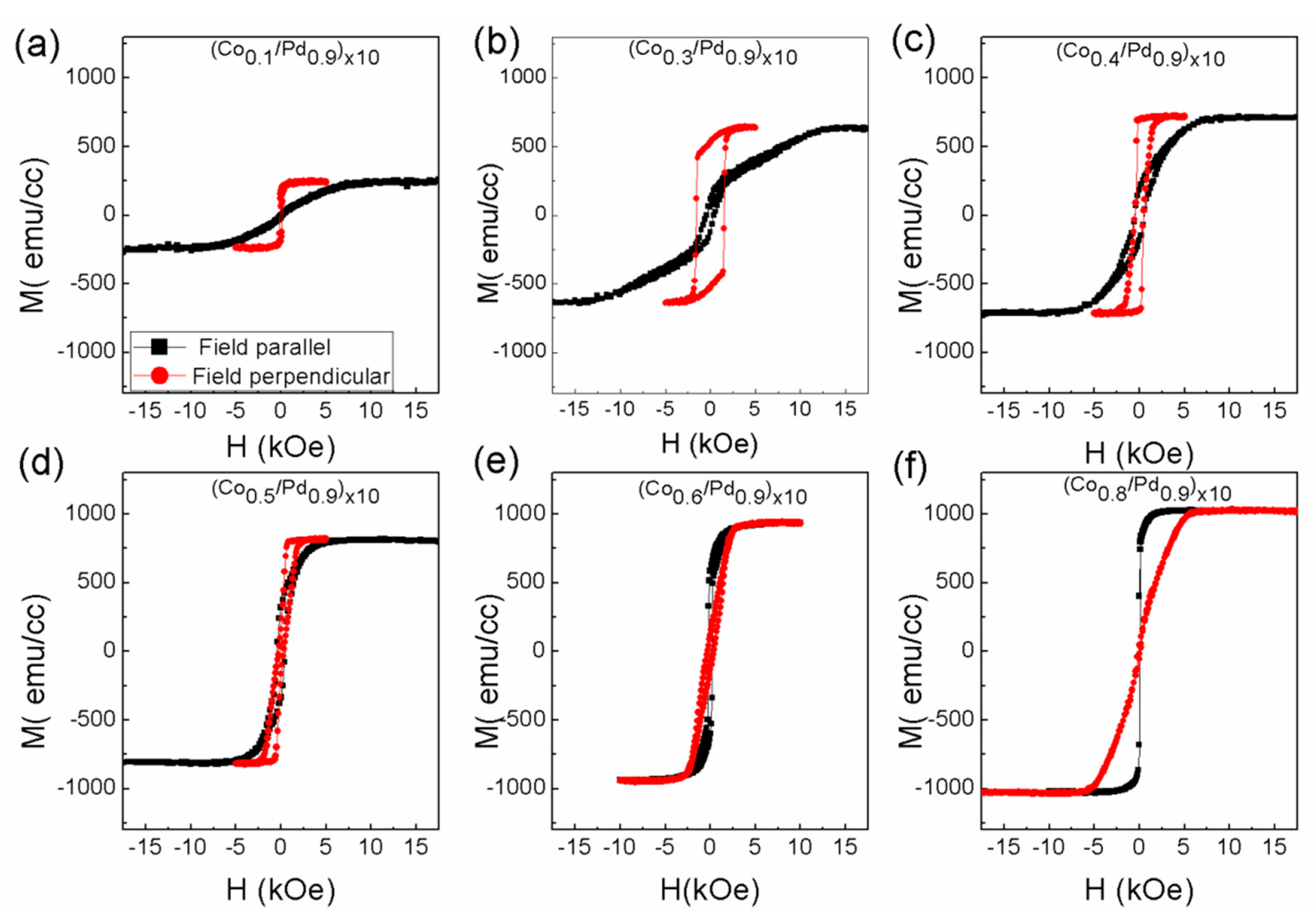

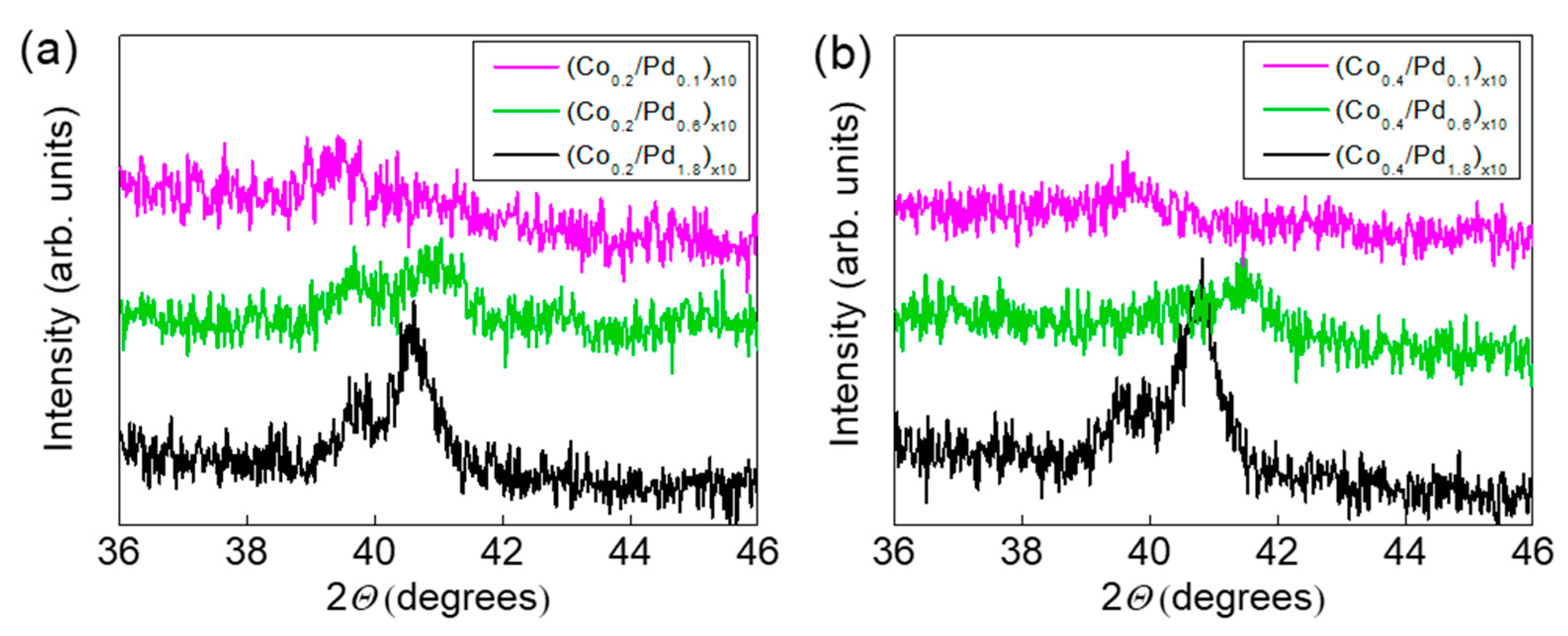
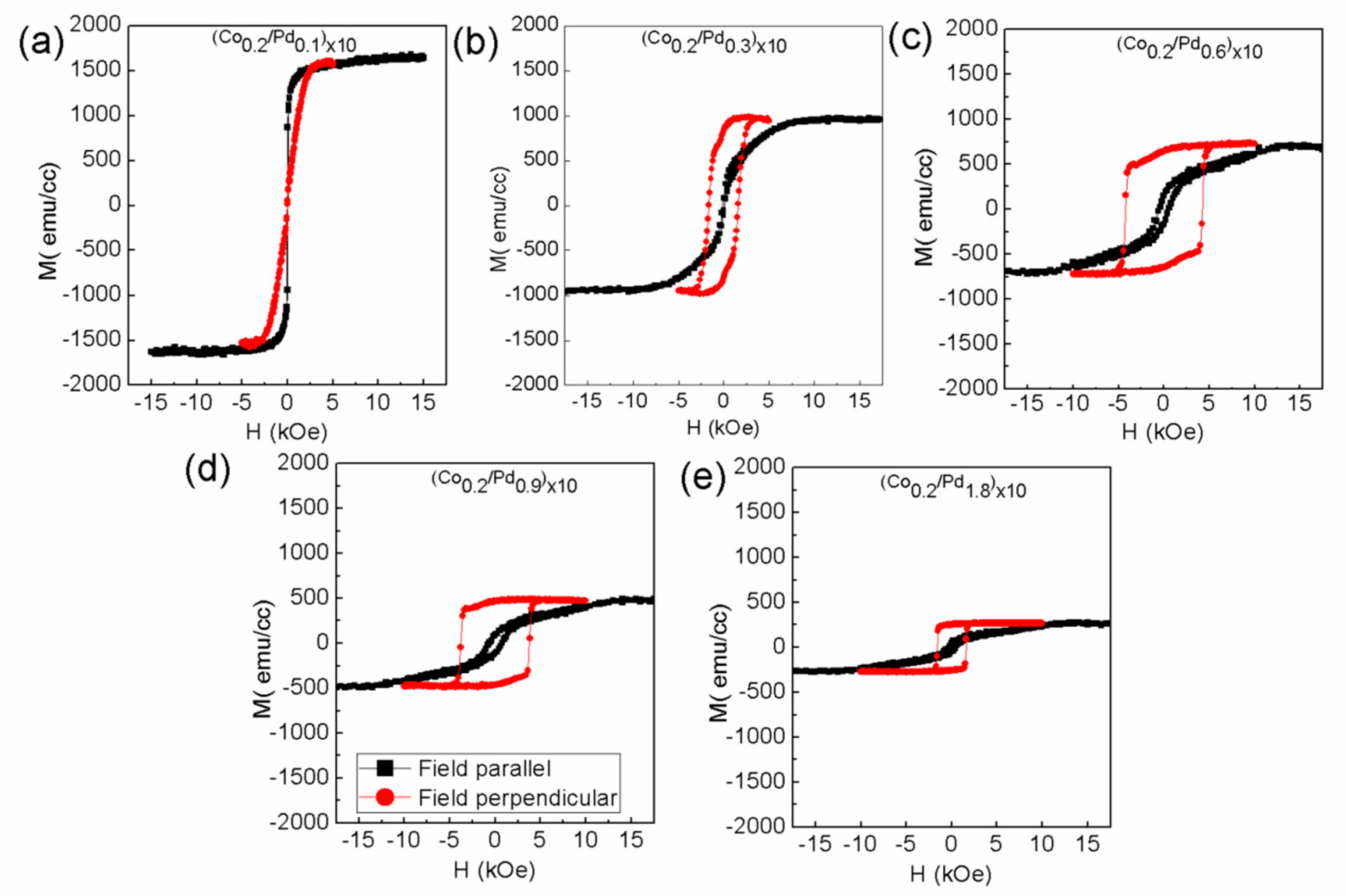
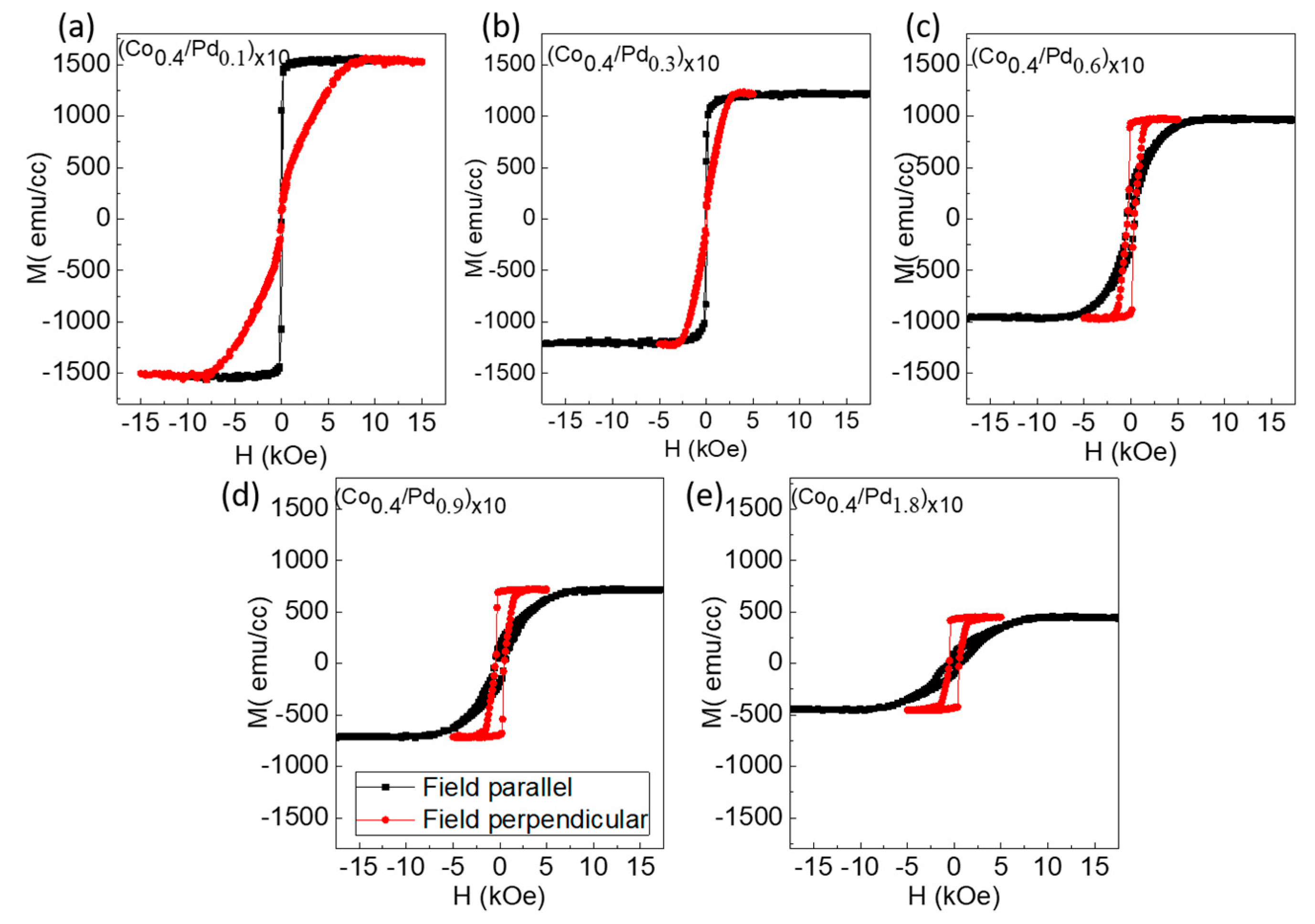
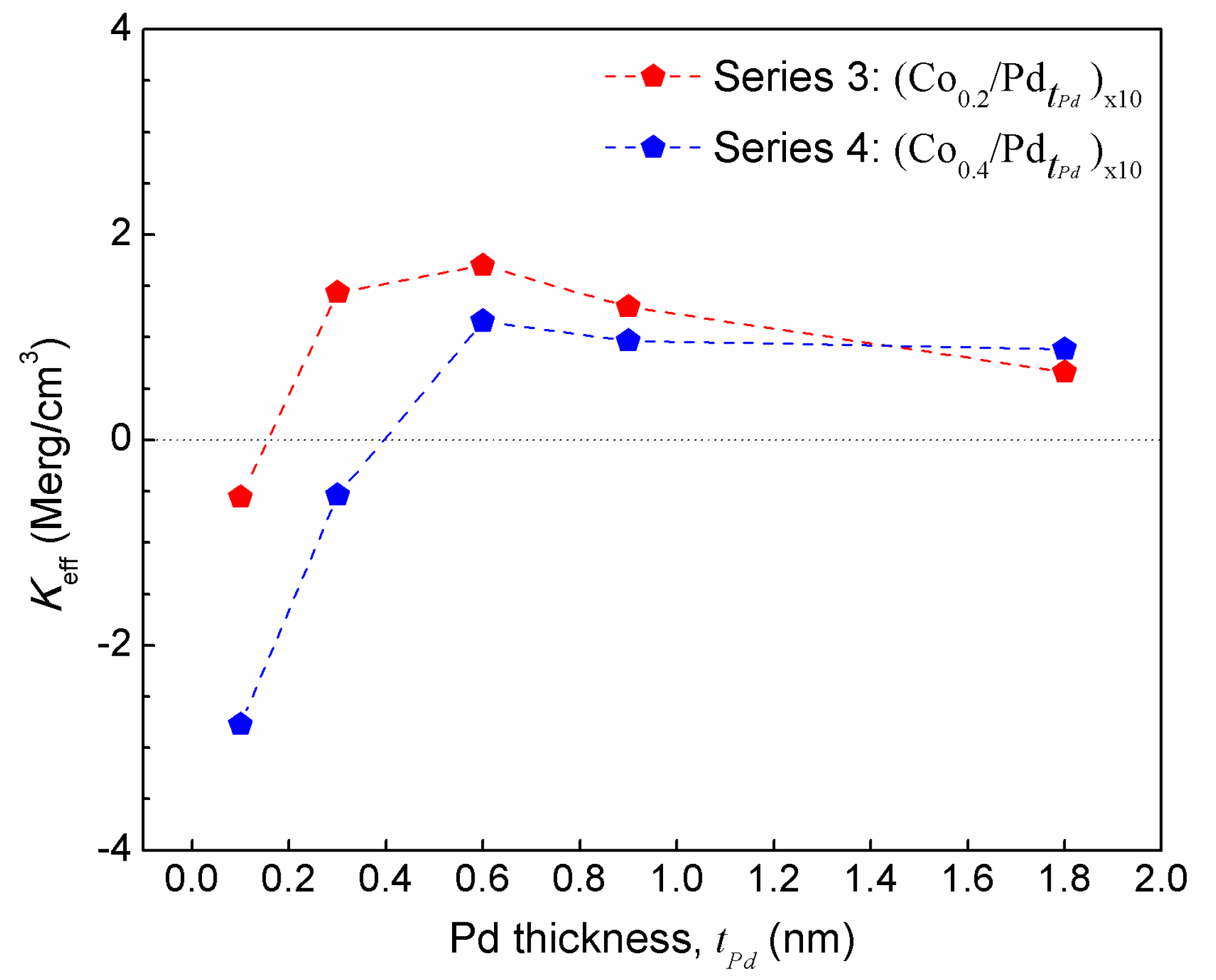

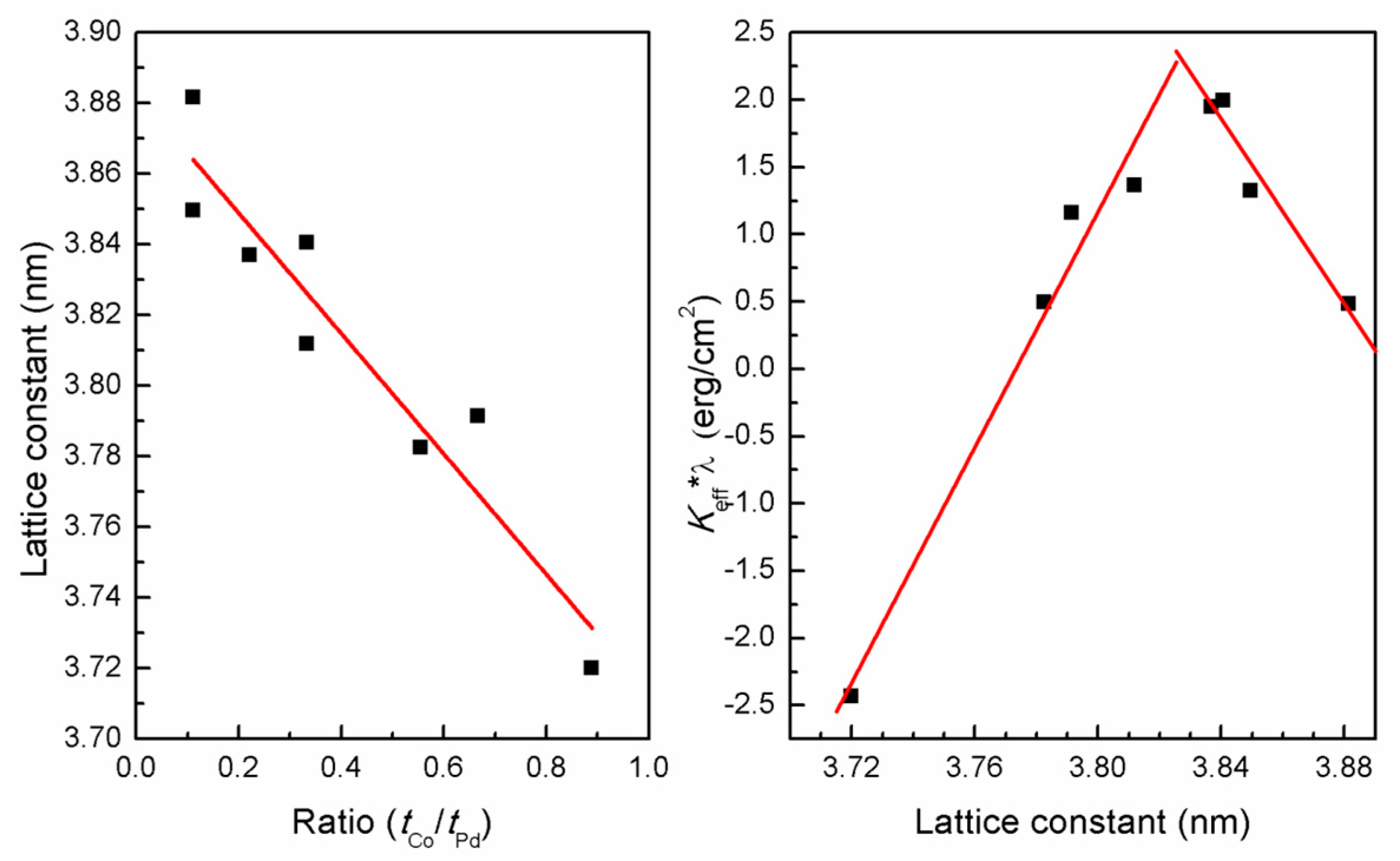
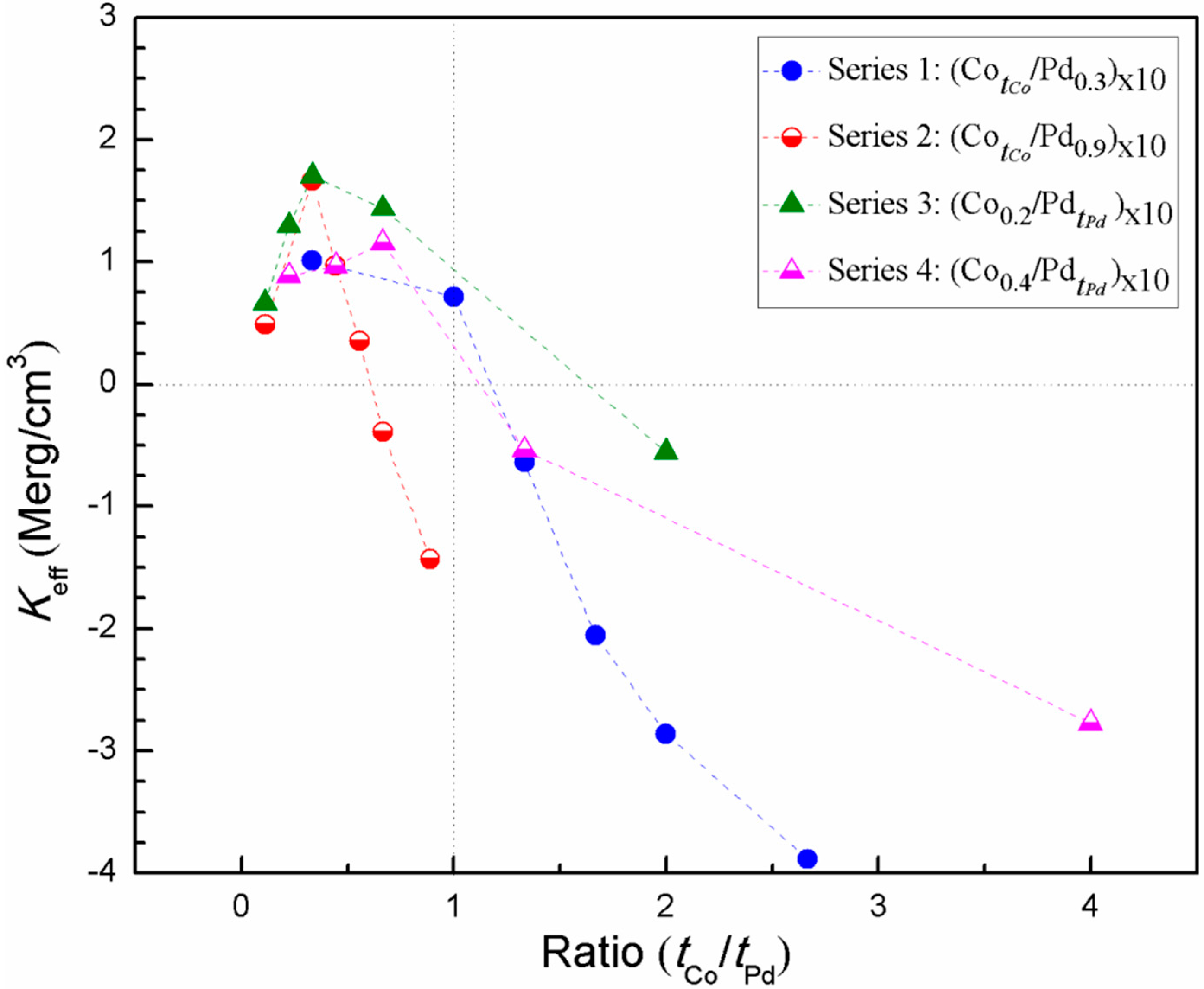
| Serial No. | Co Thickness, (nm) | Saturation Magnetization for Series 1 (emu/cm3) | Saturation Magnetization for Series 2 (emu/cm3) |
|---|---|---|---|
| 1 | 0.1 | 350 | 140 |
| 2 | 0.3 | 700 | 350 |
| 3 | 0.4 | 800 | 431 |
| 4 | 0.5 | 875 | 500 |
| 5 | 0.6 | 933 | 560 |
| 6 | 0.8 | 1018 | 659 |
| Serial No. | Pd Thickness, (nm) | Saturation Magnetization for Series 3 (emu/cm3) | Saturation Magnetization for Series 4 (emu/cm3) |
|---|---|---|---|
| 1 | 0.1 | 933 | 1120 |
| 2 | 0.3 | 560 | 800 |
| 3 | 0.6 | 350 | 560 |
| 4 | 0.9 | 254 | 431 |
| 5 | 1.8 | 140 | 255 |
© 2017 by the authors. Licensee MDPI, Basel, Switzerland. This article is an open access article distributed under the terms and conditions of the Creative Commons Attribution (CC BY) license (http://creativecommons.org/licenses/by/4.0/).
Share and Cite
Tudu, B.; Tian, K.; Tiwari, A. Effect of Composition and Thickness on the Perpendicular Magnetic Anisotropy of (Co/Pd) Multilayers. Sensors 2017, 17, 2743. https://doi.org/10.3390/s17122743
Tudu B, Tian K, Tiwari A. Effect of Composition and Thickness on the Perpendicular Magnetic Anisotropy of (Co/Pd) Multilayers. Sensors. 2017; 17(12):2743. https://doi.org/10.3390/s17122743
Chicago/Turabian StyleTudu, Bharati, Kun Tian, and Ashutosh Tiwari. 2017. "Effect of Composition and Thickness on the Perpendicular Magnetic Anisotropy of (Co/Pd) Multilayers" Sensors 17, no. 12: 2743. https://doi.org/10.3390/s17122743



